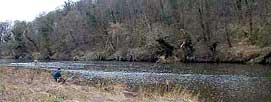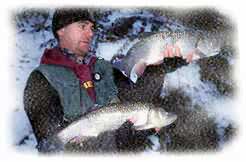The River Ribble starts its life in the Western extreme of the Yorkshire Dales. Flowing south it soon passes through Settle moving out of the ‘white rose’ county and into Lancashire. Meandering through Paythorne, Sawley and Clitheroe the river eventually reaches Hodder foot where the Ribble and Hodder join forces. Above this confluence the water flows over clean gravel and bedrock, noisily bubbling through a series of shallow glides, short runs and deep pools. This area is largely owned, managed and preserved by small and exclusive game angling clubs where coarse fishing is usually banned and at best merely tolerated.

Once below the confluence, the Ribble continues its journey through Ribchester and Balderstone, passing below the M6 Motorway before reaching Preston, finally reaching the coastline below Lytham.
For the last couple of years most of my chub fishing has concentrated on the area between Ribchester and Preston and it is this area which will be of most interest to the coarse angler. The river here varies considerably. Around Ribchester it resembles the upper reaches (albeit on a larger scale) flowing relatively fast over large boulders, pebbles and gravel. As it reaches Preston the river has again changed character, slowing down considerably with the bed now covered with a layer of silt with deeper, slower stretches becoming more prevalent.
As a schoolboy my father took me to fish the Ribble on many occasions. It was then, as it is now, a beautiful river, and considering most of my fishing adventures of the time would be on the local farm pond or canal, the powerful flow pushing through the Ribble valley seemed a huge, daunting prospect. This, however, was not so, for below its surface the river was alive with shoals of fish. If a steady glide could be found then a gentle trickle of maggots (at the time they had to be bronze!) and a crudely presented stick float would bring a succession of dace and roach to the net. Every now and then one of the ‘dace’ would tear off downstream with me back-winding furiously, several minutes later a fat chub of a couple of pounds or so would glide over the rim of the landing net. With my heart still pounding I would slip him into the keepnet to join the mass of small dace. These memories are as vivid now as they were then, some 20 years ago.
The river has changed now, not so much in appearance, for the Ribble Valley is as breathtaking now as it was then. The real change happened within the river itself. Gone are the huge shoals of dace and roach, ravaged by the cormorants. Each winter the small silver fish would gather in the deeper bends and pools. At famous winter venues anglers would continuously empty their keepnets as fish after fish came to hand. This was soon to change, each winter the cormorants would appear, forced from their hunting grounds on the North sea by the constant trawling of their prey, they swept inland across the country. On the Ribble they could be seen in large numbers perched on the tall leafless trees that seemed to surround each of these fish-gathering places. Within a few short years the birds had taken their toll, large areas of the river seemed totally barren, anglers started to disappear, and the banks soon became quiet.
They say every cloud has a silver lining, and for the specimen angler this would appear to be so. Despite the ravages of the cormorants the chub managed to hold their own, barbel had also been stocked and these two species began to dominate. Although the barbel remained quite localised the chub began to appear everywhere. In my earlier years they averaged around one and a half to two pounds. The whispers now were that 4lb chub were being caught. At the time I was travelling regularly to the Upper Severn, another beautiful and under-fished stretch of water but a near 200 mile round trip. It soon became apparent that if the word was true and good chub were again showing in the Ribble, I could be fishing for these midweek by travelling straight from work.

These rumours can only be ignored for so long and so, for the first time in many years, armed with a tub of sweetcorn and a loaf of bread, I made the short trip North to fish the Ribble. Upon arrival memories came flooding back. It was everything I had remembered. Running clear and strong, I almost ran to the water’s edge. Resisting the urge to cast in the first swim I came to I placed my gear on the grass and started to take stock. I had chosen a stretch of water near Balderstone and was soon walking the bank looking for likely swims. I settled for a long glide of reasonably fast water where the main current cut a slightly deeper channel around one third of the way across. I have found that chub (not necessarily the bigger ones) in summer prefer fast oxygenated water so this seemed the ideal swim for a few bites. It would be a short session after work, and as it was a glorious summer’s evening I was determined to enjoy myself. It was with this in mind that I chose the aforementioned swim. I fished into dark and after switching from sweetcorn to bread (to avoid the eels which seem to occupy every single swim in summer) I started to catch. The result – half a dozen chub all over 3lb with a best 4.04. For a first visit, with little current knowledge, to say this was a result would be a huge understatement.
This was to be the first of many evenings spent on the river. I would head for work with my gear in the back of the van, knowing that within an hour of leaving work I would be on the bank. Steve Plant, my angling partner for several years, would join me and together we began to explore the many stretches available on day ticket and (relatively) inexpensive club cards. Soon our catches began to escalate as our knowledge of the river increased. It would be a poor session when less than half a dozen chub each graced our nets and fish of 4lb plus were becoming commonplace.
Up until this point we had served our chub fishing apprenticeship on small intimate rivers such as the Dane and Upper Severn. Fish location on these smaller rivers was comparatively easy and usually consisted of finding the usual chub hiding places of overhanging trees, rafts and undercut banks. The Ribble however was an entirely different prospect. Being generally much wider (30-40yards) with margins consisting largely of shallow gravel our techniques both for fish location and bait presentation had to be drastically re-appraised. Previously 90% of our chub would come from within a couple of feet of the near bank using just enough lead to get our bait down. The bait would then gradually be inched into the desired position. What we now faced was the prospect of little of no bankside cover, crystal clear water, extensive shallow margins and in general a much faster current.
Obviously, fish location would prove to be the most important aspect of out new approach.
As the ‘typical’ small river chub swims were generally not present on the Ribble we began to search the river for features that the chub seemed to frequent. The number one feature we discovered was one which is favoured on both small and large rivers – the ‘crease’. The crease has best been described as the area of water where two currents of different speed join, causing a distinctive line on the water’s surface. On a small river these creases can be as little as a few yards long and are usually caused by fallen trees or other bankside protrusions. However on larger rivers the crease is generally much longer and is caused by sharp bends or contour changes of the river bed. These have proved to hold large numbers of fish and if fished correctly multiple catches can be taken from these hotspots. As a general guide we found that the chub would be found in the turbulent water in summer, often the fast weed-strewn glides at the head and tails of pools. As the temperatures cooled they would move into deeper, more sedate areas where










